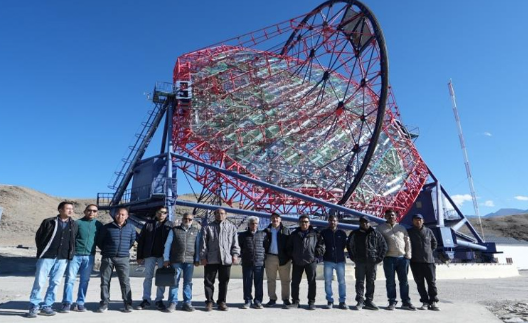India Inaugurates Asia’s Largest Cherenkov Telescope in Ladakh
In Hanle, Ladakh, the Major Atmospheric Cherenkov Experiment (MACE), Asia’s largest imaging Cherenkov telescope, was inaugurated at an impressive altitude of nearly 4,300 meters. Developed by the Bhabha Atomic Research Centre (BARC) in collaboration with several Indian industries, this marks a major step forward in India’s ability to study cosmic rays, which are high-energy particles from space.
How Does MACE Work?
Although gamma rays, a form of high-energy radiation from space, cannot pass through the Earth’s atmosphere, they create particles that release flashes of light called Cherenkov radiation when they interact with the atmosphere. This radiation is similar to the sonic boom of an aircraft but happens with light. MACE captures these light flashes through its mirrors and cameras, helping scientists trace them back to their cosmic sources, such as supernovas or black holes.
Why Was Hanle Chosen for MACE?
Hanle offers ideal conditions for a telescope like MACE because of its clear skies and minimal light pollution, which are crucial for detecting faint gamma ray signals. The region’s high altitude also reduces the interference from Earth’s atmosphere, making it easier to observe cosmic rays.
Hanle is expected to become a major center for gamma ray studies with its perfect conditions. The site’s success with MACE could lead to the installation of more telescopes and greater international collaborations, bringing astronomers from around the world to study the mysteries of the universe.
About MACE Observatory
MACE is the world’s highest atmospheric Cherenkov telescope, measuring 21 meters in diameter and weighing 175 tonnes. Its enormous reflector has an area of 356 square meters, made up of 1,424 diamond-turned metallic mirrors. The telescope is equipped with 712 actuators, which help adjust its mirrors, 1,088 photo-multiplier tubes (used to detect faint light), and 68 camera modules. Despite its large size, the design ensures that the structure remains lightweight yet durable enough to withstand extreme temperatures and challenging weather conditions. Advanced electronics help MACE efficiently gather and process light signals from space.
Month: Current Affairs - October, 2024
Category: India Nation & States Current Affairs



